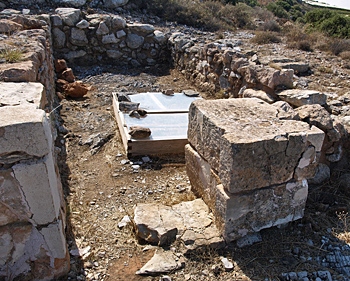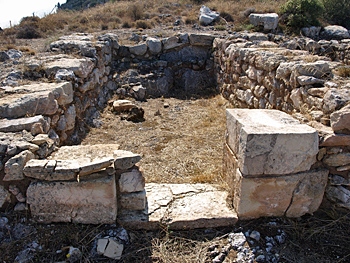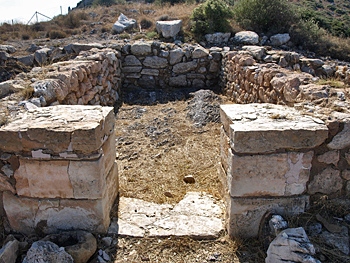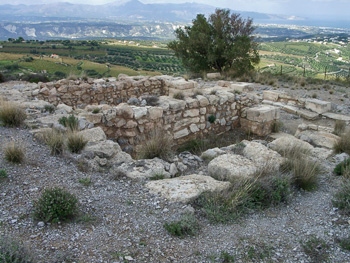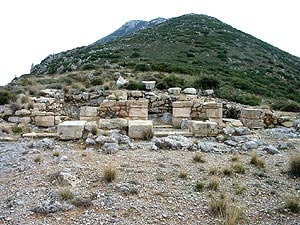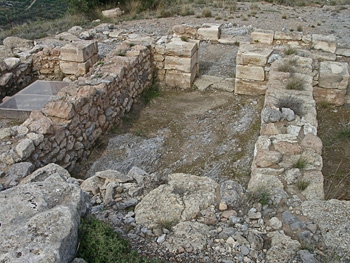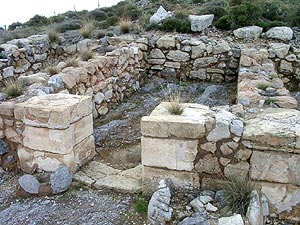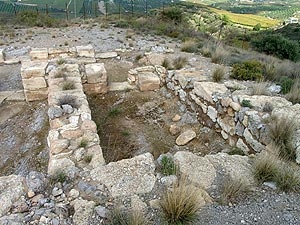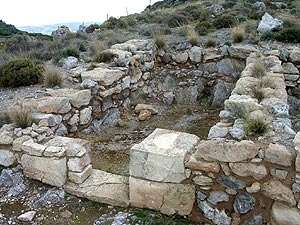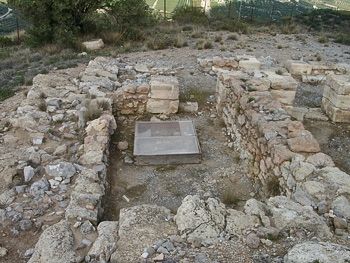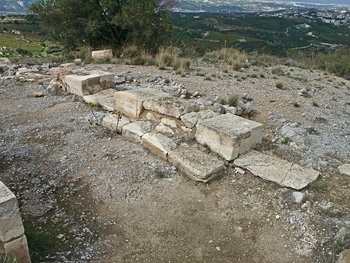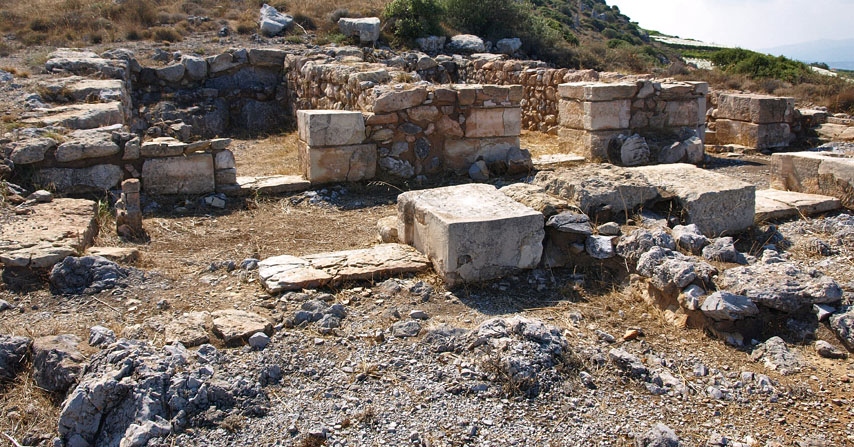
A unique temple?
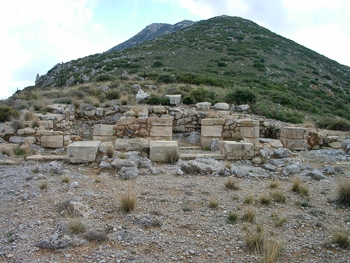
View from the north. In front of the building is the
antechamber. To the left is the room for non-blood
sacrifices. Blood sacrifies took place in the room
to the right.
The 'temple' of Anemospilia is located at the northern end of Mount Iuktas, overlooking arable land and modern day Heraklion, with extensive views both to the east and the west. The site was excavated by J. Sakellarakis in 1979, and given its small size, turned out to be one of the most controversial excavations to have taken place in Crete.
The building is unusual for a Minoan site in that it is more symmetrical and less labyrinthine than most Minoan remains. The simple design consists of three rectangular rooms in a row, and a corridor or antechamber running the length of the three rooms to the north of the building. There is no other example of such a building from the Minoan-Mycenean periods. However, Dennis Hughes points out in his book "Human Sacrifice in Ancient Greece" that to the north of the building there are three doorways corresponding to the three entrances to the rooms on the south and there is a fourth, wider entrance at the east end of the hall. Unfortunately the area north of the corridor is so heavily eroded that only the barest remains of two walls leading north from the corridor can still be seen.
The 'temple' was destroyed early in the 17th century BCE, as witnessed by finds of MM II and MM IIIA pottery styles on the site. It was almost certainly destroyed by earthquake, following which the lamps placed inside the shrine burnt whatever was flammable. Further evidence for an earthquake comes from the skeleton of a man found in the antechamber. He had been holding a vase, possibly containing blood as it resembled one to be seen on the Agia Triada sarcophagus into which the blood of a sacrficed bull is dripping. The position of the body suggests that the person was running from the building when it collapsed and killed him.
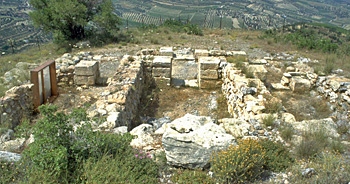
View from the south. The room in which the
human sacrifice is said to have taken place is
on the left.
The antechamber was the place where the preparation of ritual acts would have taken place. Among the finds here were vases, pithoi, mortars and pestles and tripod cooking pots. The pithoi would have stored various foodstuffs and woven cloth.
The central room was full of larger utensils, and almost the whole floor was covered with vases. Along the south wall there was a bench which may have been used both for sitting on and for placing cult objects. The most interesting find in this room was a pair of larger-than-life-size clay feet and ash from a burnt wooden object. This evidence suggests that there was originally a large statue here. The body would have been made of wood and slotted onto two sticks at the top of the clay feet. The body would have been dressed in material and the feet would not have been visible. It is possible that the statue originally stood on the bench next to the only piece of bare rock which intruded into the building, deliberately allowed to do so as it represented "sacred earth".
The eastern room was where bloodless ritual ceremonies took place. Along the south wall there was a stepped altar. The finds here were smaller in size than in the central room and included two small bronze boxes similar in design to others found at Mycenae and in the Mycenaean royal burial at Tholos Tomb A in Phourni cemetery near Archanes. Large bowls were placed on the stepped altar and it is known that these would have been used for offerings of agricultural produce -- fruit, crops, vegetables, wine and oil.
Human blood sacrifice?
The west room is, in many ways, the most interesting. First of all, unlike the other two rooms, the entrance is not in the centre of the wall but to the east so it is out of alignment with the entrance into the antechamber. It is claimed that this room was used for blood sacrifices using bulls. However, Hughes points out that bulls would have been too big to move through the corridor, packed as it was with pottery and then make a sudden turn into what is a remarkably small room.
Uniquely in Crete, three skeletons were found in the room in what was after all not a burial context. Two of these people, a man and a woman, had been killed by the earthquake and resulting fire. Another skeleton of a young male was also found in the room. This body was found lying on what the excavator claimed was a low altar-like construction. A blade was resting on the skeleton. One of the feet was in a strange position with the heel pulled right back until it was touching the back of the thigh. It has been suggested by the excavator that the feet had been tied and that the young man had been sacrificed and the blood drained from his body. The argument goes that the normal victims of sacrifice would have been bulls, but in the face of seismic activity which threatened the whole community, it may have been considered necessary to make a human sacrifice.
However Hughes challenges this interpretation. He points out that a number of facts have to be established in order to support the idea that a human sacrifice took place here. Firstly it has to be established that the building was a temple or a shrine. Although it is clear that some cult activity did take place here, that is not the same as establishing the function of the building as a temple. There is no other example of such a building in Minoan Crete.
Secondly, it has to be established that the low 'altar-like' structure of loose stones was in fact an altar. In Hughes's view this is most unlikely. Iconographic evidence suggests that altars for sacrificing large animals like bulls, which the excavator claims was the usual use for this part of the building, were "large movable platforms supported by legs" and since none has survived anywhere in Crete it is assumed they were made of wood.
Thirdly, it has to be established that the blade was a sacrificial knife. However, this seems unlikely. The blade was very large and it has generally been accepted that it was in fact a spear. The fact that it was lying across the skeleton does not of itself prove that it was used to kill the 'victim'. In fact, this is something that archaeology is unable to prove. The spear could just as easily have been leaning against a wall and it fell across the body of the young man during the earthquake.
Fourthly it is not at all certain that the young man had been tied up. If he had been, why was his other leg not in the same position? And why did his hands show no sign of having been tied up?
Finally, the excavator pointed out that the colour of the bones in the top half of the skeleton was different from the colour of the bones in the bottom half of the skeleton. This has been accounted for by suggesting that because the 'victim' had lost a lot of blood before the earthquake and fire, his remains burned differently on the top half which had little blood in them from the bottom half where the remaining blood in the body had settled.
However, there are many possible explanations for why the different parts of a skeleton burn to different colours in a fire. One part may have been more exposed to burning material than the other part. Alternatively the bottom half of the body may have been protected from the most intense flames by being close to the ground.
There is a complete lack of evidence for human sacrifice throughout the Minoan period (one other often quoted example can also be given a quite innocent explanation as Hughes demonstrates in his book). It is surely best, therefore, to look at this wider context before leaping to the conclusion that a human sacrifice took place at Anemospilia.
A detailed description of the excavations and finds at Anemospilia can be found in the guide book to Archanes by J. and E. Sakellarakis, published by Ekdotike Athenon, Athens 1991.
The site is now extremely well fenced in and not generally open to the public. However, a good view of the site can be had from the south fence and the views from the road of the north coast of Crete are spectacular.


